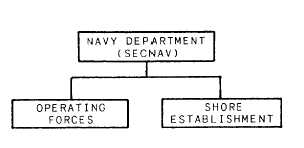foreign or domestic, the Constitution gives
Congress the power to carry out the following:
Raise and support armies
Provide and maintain a navy
Make rules for the government of the land
and the regulation of its naval forces
CONGRESSIONAL ACTION
The Continental Congress passed legislation
on 13 October 1775 to form a committee to
purchase and arm two ships. That action created
the Continental navy; and that date is, histori-
cally, the birthday of the U.S. Navy. The gallant
fighting of the Continental navy during the
revolutionary war was a large contributor to
America’s independence as a new nation. The
Continental navy began a heritage and tradition
of victory that serve as the basic doctrine of our
modern Navy.
The United States Constitution provided for
the creation of a navy under the jurisdiction of
the War Department. Article I of the Constitution
states that Congress shall have power to provide
and maintain a navy. It also states that Congress
shall have power to make rules for the government
and to regulate the land and naval forces. Article
II states that the President shall be Commander
in Chief of the Army and Navy of the United
States. (The Air Force came into being in 1947.)
These three short entries are the only specific
references to the navy in the Constitution. These
few lines, however, authorized Congress to
establish the navy, develop navy regulations, and
appoint the President as Commander in Chief.
The increasing tempo of naval matters as war
with France became certain prompted Congress
to take two actions during 1798. On 30 April
Congress acted to establish a separate Navy
Department (fig. 1-1). That action removed naval
affairs from the jurisdiction of the War
Figure 1-1.-Navy Department in 1798.
Department. On 11 July Congress established the
United States Marine Corps (USMC) as a separate
service within the Navy Department. These
actions gave the Secretary of the Navy (SECNAV)
direct control over the Shore Establishment. They
gave him as much control over the operating
forces as existing communications permitted. This
change in the Navy’s organization lasted through
the nation’s conflict with France, the Tripolitan
War (1801-1805), and the War of 1812. During
that period, naval shipyards and hospitals became
parts of the Shore Establishment.
MODIFICATIONS TO THE NAVY’S
ORGANIZATION
The growth of the Navy and its technology
caused Congress to create a system of bureaus in
1842. The bureaus provided for the supply of
materials and technical aid to fleet and shore
activities.
In 1915 Congress created the position of Chief
of Naval Operations (CNO) to fill SECNAV’s
need for an official naval advisor. Before World
War II, the CNO was responsible for the
operation and readiness of the fleet and the
preparation of naval war plans. In addition, he
served as an advisor to SECNAV.
During World War II, the CNO had military
command of all Shore Establishment and bureau
activities. The activities remained under the
management of SECNAV and his assistants.
After the Korean conflict, the position of
Commandant of the Marine Corps shifted within
the Navy organization. It remained a part of the
Navy Department under the Secretary of the
Navy. However, separate USMC headquarters
provided a distinction between the Navy and
Marine Corps organizations.
REFINEMENTS TO THE NAVY’S
ORGANIZATION
In 1949 an amendment to the National
Security Act of 1947 created the Department of
Defense (DOD). That amendment changed the
organizational structure of the existing military
departments. The old Navy Department became
the Department of the Navy.
The Department of the Navy has since
undergone many adjustments. These adjustments
improved coordination within the Department of
Defense and helped DON keep up with advances
in modern weapons and technology. Along with
technical and weapons bureaus, functional
1-2


